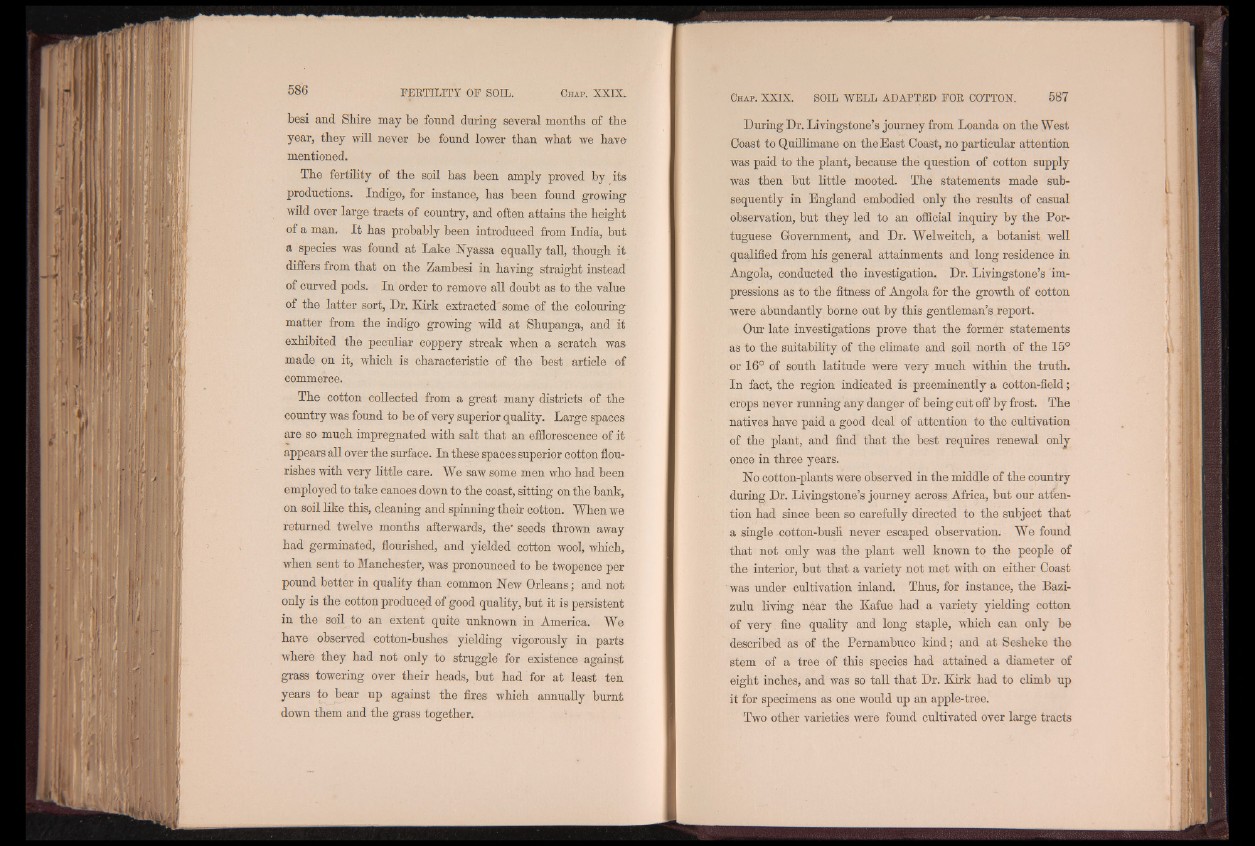
besi and Shire may be found during several months of the
year, they will never be found lower than what we have
mentioned.
The fertility of the soil has been amply proved by its
productions. Indigo, for instance, has been found growing
wild over large tracts of country, and often attains the height
of a man. I t has probably been introduced from India, but
a species was found at Lake Nyassa equally tall, though it
differs from that on the Zambesi in having straight instead
of curved pods. In order to remove all doubt as to the value
of the latter sort, Dr. Kirk extracted'some of the colouring
matter from the indigo growing wild at Shupanga, and it
exhibited the peculiar coppery streak when a scratch was
made on it, which is characteristic of the best article of
commerce.
The cotton collected from a great many districts of the
country was found to be of very superior quality. Large spaces
are so much impregnated with salt that an efflorescence of it
appears all over the surface. In these spaces superior cotton flourishes
with very little care. We saw some men who had been
employed to take canoes down to the coast, sitting on the bank,
on soil like this, cleaning and spinning their cotton. When we
returned twelve months afterwards, the' seeds thrown away
had germinated, flourished, and yielded cotton wool, which,
when sent to Manchester, was pronounced to be twopence per
pound better in quality than common New Orleans; and not
only is the cotton produced of good quality, but it is persistent
in the soil to an extent quite unknown in America. We
have observed cotton-bushes yielding vigorously in parts
where they had not only to struggle for existence against
grass towering over their heads, but had for at least ten
years to bear up against the fires which annually burnt
down them and the grass together.
During Dr. Livingstone’s journey from Loanda on the West
Coast to Quillimane on the East Coast, no particular attention
was paid to the plant, because the question of cotton supply
was then but little mooted. The statements made subsequently
in England embodied only the results of casual
observation, but they led to an official inquiry by the Portuguese
Government, and Dr. Welweitch, a botanist well
qualified from his general attainments and long residence in
Angola, conducted the investigation. Dr. Livingstone’s impressions
as to the fitness of Angola for the growth of cotton
were abundantly borne out by this gentleman’s report.
Our late investigations prove that the former statements
as to the suitability of the climate and soil north of the 15°
or 16° of south latitude were very much within the truth.
In fact, the region indicated is preeminently a cotton-field;
crops never running any danger of being cut off by frost. The
natives have paid a good deal of attention to the cultivation
of the plant, and find that the best requires renewal only
once in three years.
No cotton-plants were observed in the middle of the country
during Dr. Livingstone’s journey across Africa, but our attention
had since been so carefully directed to the subject that
a single cotton-bush never escaped observation. We found
that not only was the plant well known to the people of
the interior, but that a variety not met with on either Coast
was under cultivation inland. Thus, for instance, the Bazi-
zulu living near the Kafue had a variety yielding cotton
of very fine quality and long staple, which can only be
described as of the Pernambuco kind; and at Sesheke the
stem of a tree of this species had attained a diameter of
eight inches, and was so tall that Dr. Kirk had to climb up
it for specimens as one would up an apple-tree.
Two other varieties were found cultivated over large tracts